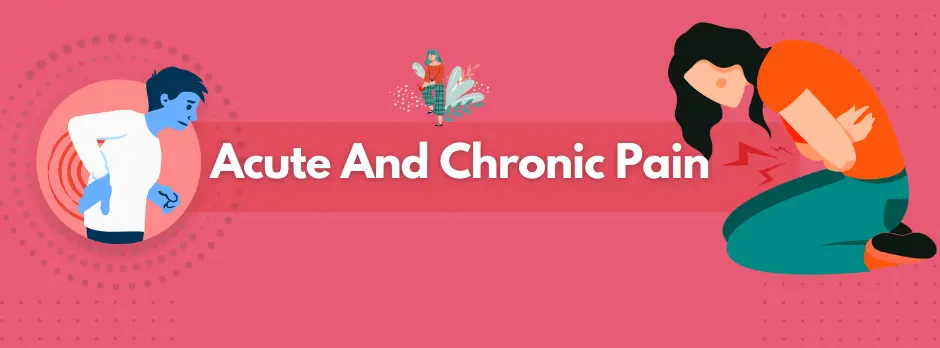
From headaches to toothaches, we have all experienced some type of pain at some point in our lives. In most cases, this pain is temporary; however, at other times, it can last for several weeks, months, or even years. Its cause, location, longevity, and circumstances all contribute to how doctors treat that pain and help you live the healthiest life possible.
Pain: A Brief Introduction
Pain is an uncomfortable or uneasy sensation that usually indicates an injury or illness. It is a body’s way of telling you something isn’t alright. Pain can range from mild to moderate to severe. It may feel like a dull ache or sharp stab or be described as pinching, burning, throbbing, or sore [1].
There are different types of pain, but here we’ll discuss the most common types: acute and chronic pain.
Difference Between Acute And Chronic Pain
Acute Pain
Acute pain is a type of pain that lasts for a short duration, from minutes to about three months (sometimes for six months). It also tends to be related to a temporary illness or a soft-tissue injury, so it typically subsides after the injury heals or the illness subsides [2].
Chronic Pain
Chronic pain is a type of pain that is persistent and usually lasts for a prolonged duration of more than three months. This type of pain continues even after the illness or injury that has caused it has gone away or healed.
Signs And Symptoms Of Acute Pain And Chronic Pain

Signs And Symptoms Of Acute Pain
The most common signs and symptoms of acute pain are –
- Burning
- Numbness
- Pain that feels like something is stabbing you
- Pain that seems to have a heartbeat
- Weakness
- Tingling [3].
Signs And Symptoms Of Chronic Pain
The signs and symptoms of chronic pain vary. One may feel pain or stiffness that [4] –
- Dull
- Sharp
- Throbbing
- Burning.
This type of pain may also cause you to –
- Have trouble sleeping
- Have mood changes
- Feel tired.
Causes Of Acute And Chronic Pain
Causes Of Acute Pain
Five causes of acute pain include –
- Burns or cuts
- Dental work
- Broken bones
- Surgery
- Labor and childbirth
Causes Of Chronic Pain
A few causes of chronic pain include –
- Arthritis – inflammation of the joints.
- Headache
- Cancer pain
- Nerve pain
- Back pain
- Fibromyalgia – pain and tenderness in the whole body.
If you have chronic pain, the stress of the pain affects the body, causing physical conditions like a lack of energy, tense muscles, changes in appetite, and limited ability to move around.
If you are interested in knowing more about the causes of chronic pain, Healthline offers a detailed and informative guide on the topic.
The Impact of Acute and Chronic Pain

Understanding the impacts of both types of pain is essential for providing comprehensive care and support.
Physical effects of acute and chronic pain –
- Chronic and acute pain can restrict movement and physical function, hindering the ability to do daily activities.
- Acute and chronic pain can make it difficult to fall asleep, leading to insomnia and fatigue.
Emotional Effects Of Chronic and Acute Pain –
- The limitations and uncertainty associated with chronic and acute pain can trigger anxiety and fear.
- Acute and chronic pain can lead to irritability and frustration due to inference in your everyday activities.
Social Effects Of Acute And Chronic Pain –
- Chronic and acute pain can limit social interactions temporarily and participation in activities.
- Chronic and acute pain can significantly affect relationships with friends and family, often creating emotional strain and communication challenges.
Body pain (acute and chronic) can impact a person’s life drastically. Above, we have just mentioned a few ways pain can affect a person socially, emotionally, and physically.
To get a deeper look into the impacts of pain in one’s life, click the blog page 8 Ways How Pain Can Impact Your Life by Dr. (Prof.) Mary Abraham.
Acute And Chronic Pain Diagnosis
Patients must inform their healthcare providers of their medical history when diagnosed with acute or chronic pain.
The doctor will then use the patient’s description of their pain to help diagnose the cause.
They will ask the patients several questions so that the doctors can know the exact cause of their pain.
Your doctor will want to know –
- How often does the pain occur?
- Where is your pain?
- What makes it better or worse?
Apart from asking questions, your doctor may physically examine your body and order tests to determine the cause of the pain. They may recommend the following tests: Blood tests, urine tests, X-rays, MRIs, and electromyography to test muscle activity.
Treatment For Chronic And Acute Pain
Below, we have outlined the treatment options for chronic and acute pain.
Treatment Options For Acute Pain
Rest and ice – Resting the affected area and applying ice packs on that area can help reduce inflammation and pain, especially in cases of trauma or injury.
Nerve blocks – Nerve blocks involve injecting anti-inflammatory or anesthetic medication near nerves to block pain signals, providing temporary relief from pain.
Heat therapy – Heat therapy, such as heating pads, is also an excellent option for relieving acute pain by relaxing muscles and promoting blood flow.
Injections – Local anesthetic injections may directly target and alleviate pain in specific areas, such as nerve roots or joints [5].
Treatment For Chronic Pain
Trigger point injections – This procedure is used to treat painful areas of muscles that have trigger points or knots formed when muscles do not relax. During this procedure, doctors use a small needle to inject a local anesthetic into a trigger point. This makes the trigger point inactive, alleviating the pain.
Bioelectric therapy – Bioelectric therapy relieves pain by blocking pain signals to the brain. This therapy also prompts the body to produce endorphins that eliminate or decrease painful sensations by blocking the message of pain being delivered to the brain.
Physical therapy – Physical therapy helps to eliminate pain by using techniques that improve movement and function impaired by a disability or an injury. Physical therapy includes cold or heat on the part that hurts, stretching exercises, and massage, among others.
Surgery – In some instances, surgical intervention is necessary to address the underlying cause of chronic pain [6].
Different Types Of Pain Medicine For Acute And Chronic Pain At Vedi Care Health
There are different types of pain medication available to provide relief from acute and chronic pain. Some of the most effective and common pain medications available for treating acute and chronic pain are skeletal muscle relaxants, opioid pain medications, and anticonvulsants.
Skeletal Muscle Relaxant
Skeletal muscle relaxers are a group of medications used to reduce and relax pain and muscle tension caused by musculoskeletal conditions, such as muscle injury, sprain, or strain.
Skeletal muscle relaxants are usually prescribed for acute pain. Soma is one of the most effective skeletal muscle relaxers available at Vedi Care.
Soma pills, which contain carisoprodol as an active ingredient, are available under various brand names, but two of their most popular brands are Pain O Soma and Soma Dol.
Pain O Soma has been available on the market for a long time and is the most sought-after brand version of Soma pills. It is available in two dosage strengths: Pain O Soma 350 mg and Pain o Soma 500 mg.
Soma Dol, another name for carisoprodol manufactured by ScieGen Pharmaceuticals, Inc., has recently gained popularity because it comes in a higher dosage than pain-o-soma. While pain-o-soma is available in the highest dosage strength of 500 mg, the highest dose of Soma-Dol is 750 mg.
Opioid Pain Medication
Opioid pain medications are a class of prescription drugs used to treat persistent or severe pain. Two of the most common and effective types of opioid pain medication are tapentadol and tramadol.
Tapentadol is manufactured under various brand names, but Aspadol and Tapaday are some of the most popular and affordable brands for this medication.
At Vedi Care, we offer a variety of Tapentadol brand versions. Our category offers a comprehensive selection of Tapentadol products.
Tramadol is another popular opioid pain medication available under the brand name Ultram and Qdolo, among others. It is used to treat moderately severe chronic pain in adults.
Self-Help Methods For Pain Management

Here are a few ways to manage acute and chronic pain.
Meditation and breathing exercises
Meditation is a set of techniques that are intended to encourage a state of heightened awareness and focused attention.
Breathing exercises are relaxation techniques in which an individual focuses on taking slow, deep breaths.
Medication and breathing exercises help relax the body and mind, improve psychological balance, increase calmness, and minimize stress and pain.
Well-balanced eating
High-glycemic starches and processed sugars increase inflammation, which causes pain, redness, overheating, and swelling. Eating nutrient-rich foods like lean protein and more vegetables can keep the pain at bay and improve your quality of life.
Exercise
Physical workouts can play an essential role in interrupting the vicious cycle of pain and reduced mobility found in some chronic conditions, such as fibromyalgia and arthritis. People with pain can try simple aerobic exercises like walking, cycling, or swimming.
Music therapy
Listening to music can distract a person from pain and discomfort. In 2006, many independent studies reported that music may provide a practical complementary approach for relieving acute, procedural, and cancer/chronic pain [7].
Conclusion
It’s crucial to understand the differences between acute and chronic pain, as both types of pain respond differently to treatments. By recognizing the distinct characteristics, causes, and treatment options for acute and chronic pain, healthcare professionals can develop targeted interventions to eliminate symptoms and improve function and overall quality of life.
FAQs
What are some examples of acute pain?
Which is more severe, chronic or acute pain?
How do I know if my pain is chronic?
Which is the most potent drug for nerve pain?
Which is the most common chronic pain?
References
- Everything You Need To Know About Pain, Healthline
- Acute vs. Chronic Pain, Cleveland Clinic
- Acute Pain Causes, Symptoms, and Treatments, upmc
- Chronic Pain Causes, Symptoms, and Treatments, upmc
- Acute vs. chronic pain: Differences and treatments, mindset health
- Pain Management: Treatment Overview, WebMD
- The Effects of Music on Pain: A Meta-Analysis, PubMed.










